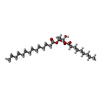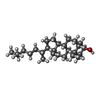+Search query
-Structure paper
| Title | Electromechanical coupling in the hyperpolarization-activated K channel KAT1. |
|---|---|
| Journal, issue, pages | Nature, Vol. 583, Issue 7814, Page 145-149, Year 2020 |
| Publish date | May 27, 2020 |
 Authors Authors | Michael David Clark / Gustavo F Contreras / Rong Shen / Eduardo Perozo /  |
| PubMed Abstract | Voltage-gated potassium (K) channels coordinate electrical signalling and control cell volume by gating in response to membrane depolarization or hyperpolarization. However, although voltage-sensing ...Voltage-gated potassium (K) channels coordinate electrical signalling and control cell volume by gating in response to membrane depolarization or hyperpolarization. However, although voltage-sensing domains transduce transmembrane electric field changes by a common mechanism involving the outward or inward translocation of gating charges, the general determinants of channel gating polarity remain poorly understood. Here we suggest a molecular mechanism for electromechanical coupling and gating polarity in non-domain-swapped K channels on the basis of the cryo-electron microscopy structure of KAT1, the hyperpolarization-activated K channel from Arabidopsis thaliana. KAT1 displays a depolarized voltage sensor, which interacts with a closed pore domain directly via two interfaces and indirectly via an intercalated phospholipid. Functional evaluation of KAT1 structure-guided mutants at the sensor-pore interfaces suggests a mechanism in which direct interaction between the sensor and the C-linker hairpin in the adjacent pore subunit is the primary determinant of gating polarity. We suggest that an inward motion of the S4 sensor helix of approximately 5-7 Å can underlie a direct-coupling mechanism, driving a conformational reorientation of the C-linker and ultimately opening the activation gate formed by the S6 intracellular bundle. This direct-coupling mechanism contrasts with allosteric mechanisms proposed for hyperpolarization-activated cyclic nucleotide-gated channels, and may represent an unexpected link between depolarization- and hyperpolarization-activated channels. |
 External links External links |  Nature / Nature /  PubMed:32461693 / PubMed:32461693 /  PubMed Central PubMed Central |
| Methods | EM (single particle) |
| Resolution | 3.5 - 3.8 Å |
| Structure data | EMDB-21018, PDB-6v1x: EMDB-21019, PDB-6v1y: |
| Chemicals |  ChemComp-QNP:  ChemComp-QNJ: |
| Source |
|
 Keywords Keywords | TRANSPORT PROTEIN / membrane protein / voltage-gated ion channel / potassium channel |
 Movie
Movie Controller
Controller Structure viewers
Structure viewers About Yorodumi Papers
About Yorodumi Papers








